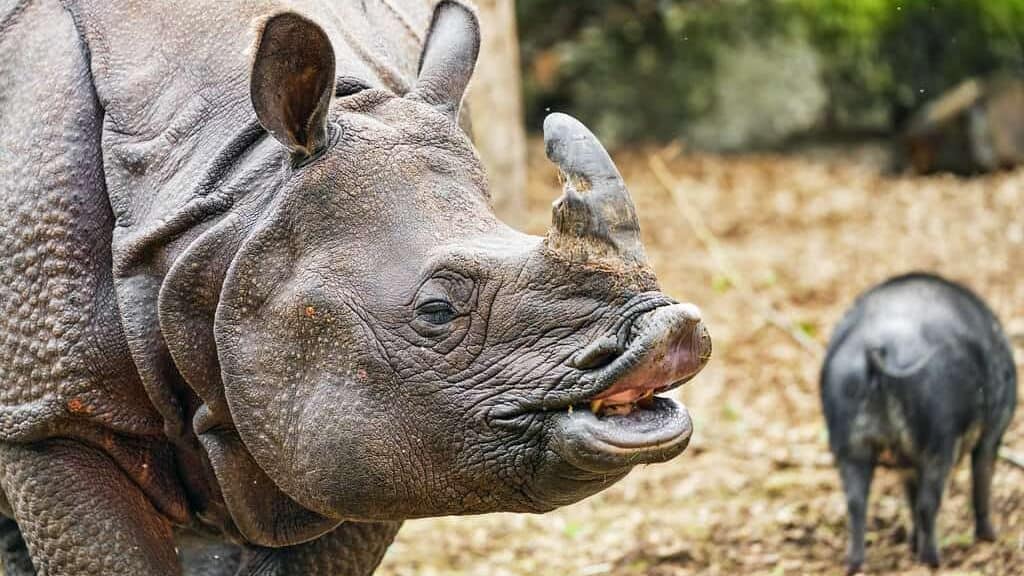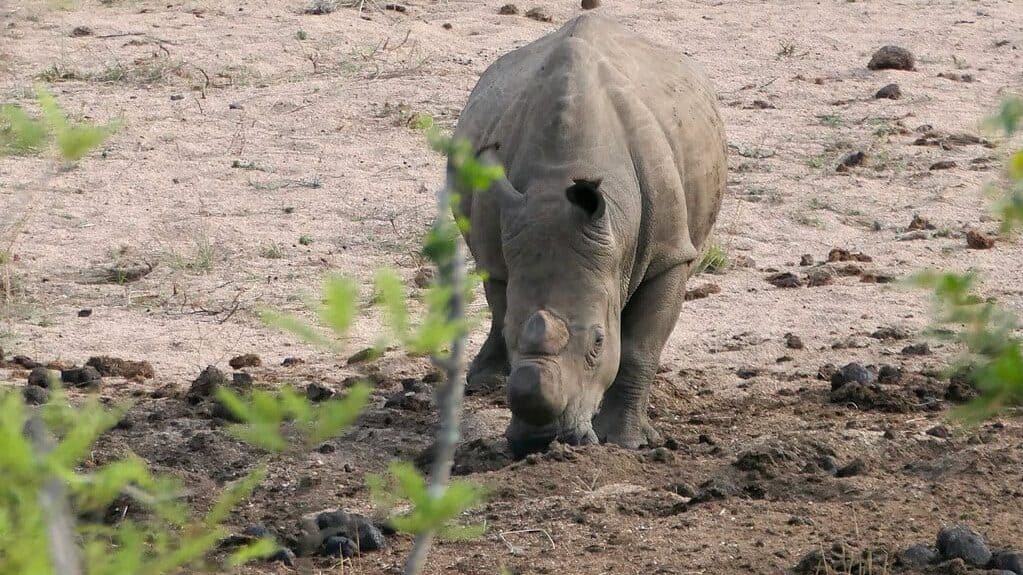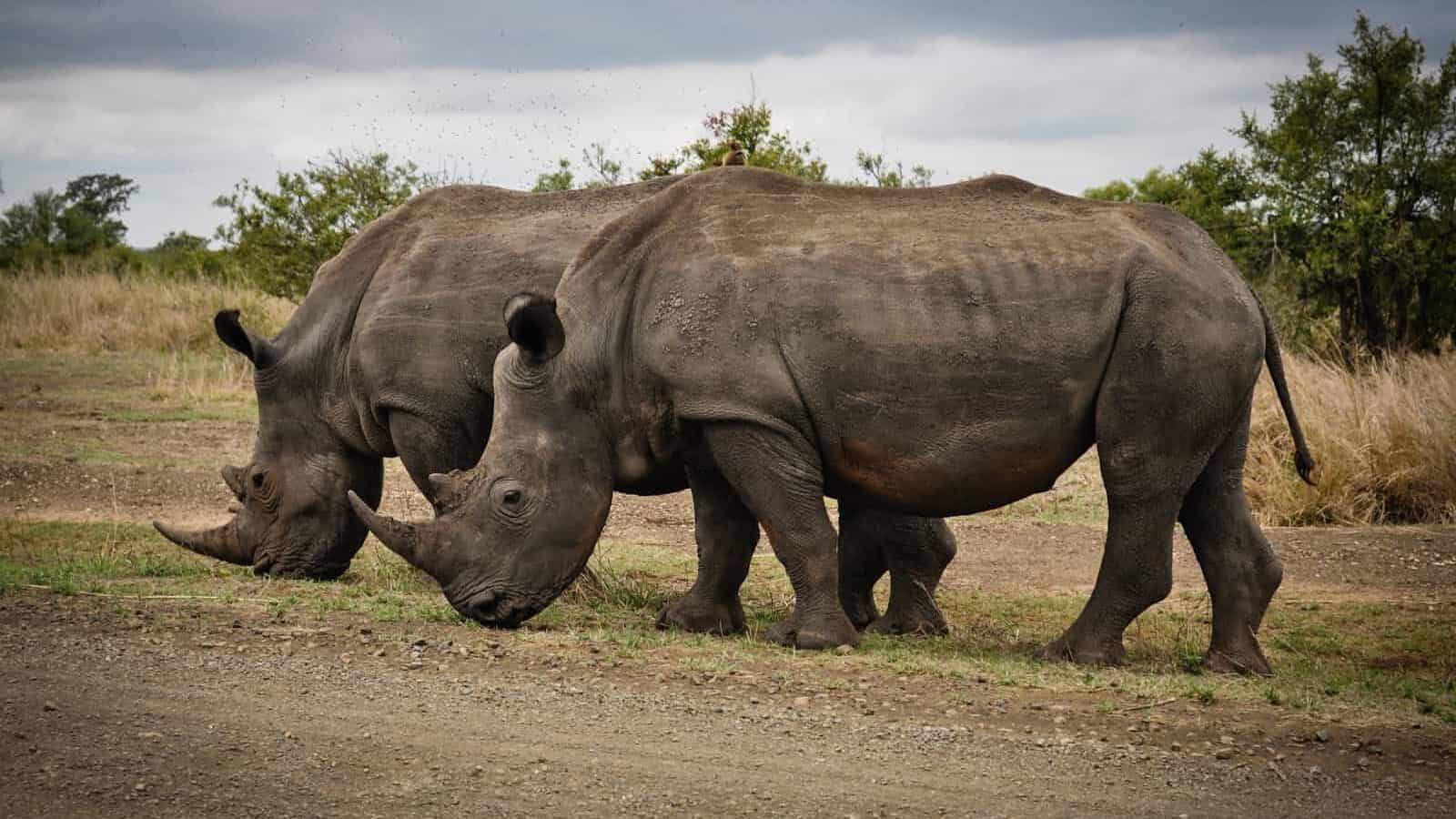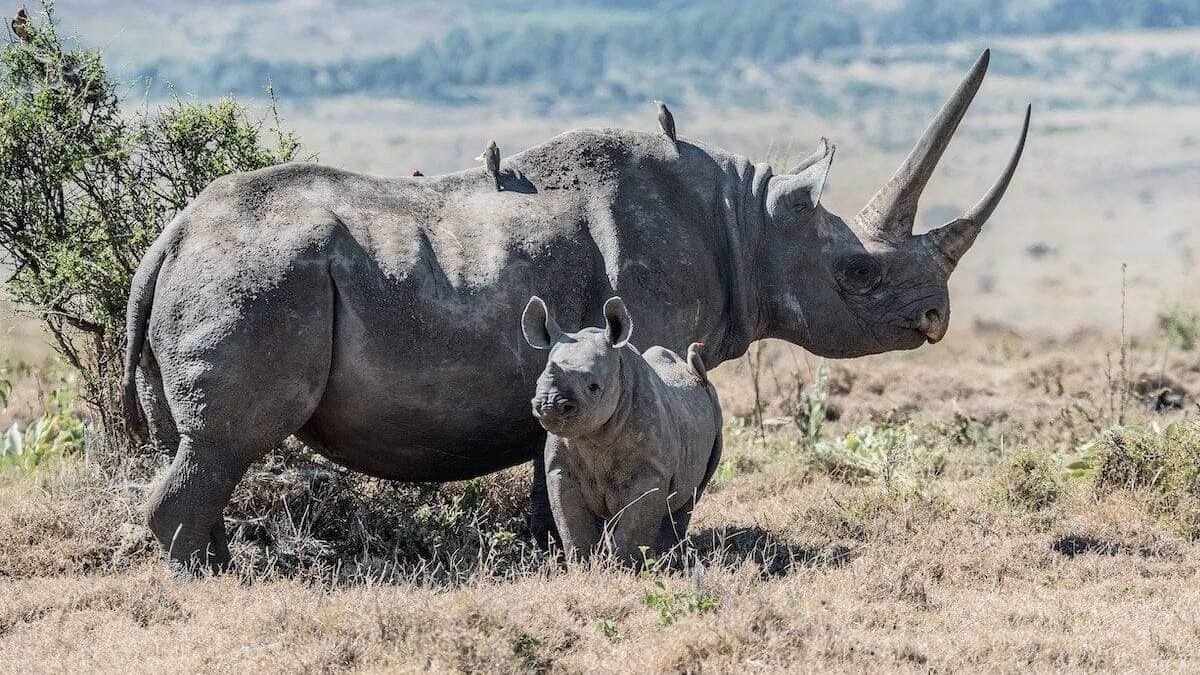In the vast expanses of African savannas and Asian forests, rhinos navigate their territories through an intricate system that remains largely invisible to human observers: scent marking. These massive, prehistoric-looking mammals rely heavily on their acute sense of smell to communicate, establish boundaries, and find their way across landscapes. Unlike humans who primarily use vision, rhinos experience their world predominantly through olfactory information, creating what scientists call “olfactory landscapes” or “smellscapes” that guide their movements and social interactions.
Rhinoceros species have developed sophisticated scent-marking behaviors over millions of years of evolution, allowing them to leave chemical messages that persist in the environment long after they’ve moved on. These olfactory signposts serve as a complex navigation system, territorial marker, and social media network all rolled into one. Understanding how rhinos use scent to navigate their world not only provides fascinating insights into their behavior but also offers critical knowledge for conservation efforts aimed at protecting these endangered creatures.
The Rhinoceros Olfactory System

Rhinos possess one of the most developed olfactory systems in the animal kingdom, with an exceptional ability to detect and interpret chemical signals. Their nasal passages contain millions of olfactory receptor cells that can identify minute concentrations of odor molecules. This extraordinary sense of smell allows rhinos to detect other animals, food sources, water, and potential mates from considerable distances, sometimes exceeding several kilometers under favorable wind conditions.
The vomeronasal organ (VNO), also known as Jacobson’s organ, plays a crucial role in a rhino’s ability to process pheromones and other chemical signals. Located in the nasal cavity, this specialized sensory organ provides rhinos with detailed information about the reproductive status, identity, and health of other individuals. When a rhino encounters a scent mark, it often performs a behavior called “flehmen,” where it curls back its upper lip to direct air and scent molecules toward the VNO, allowing for deeper analysis of the chemical information.
Middens: Rhino Social Media Platforms

One of the most distinctive scent-marking behaviors of rhinos involves the creation and maintenance of communal dung piles known as middens. These strategic locations serve as information hubs where multiple rhinos deposit their dung, creating a central database of olfactory information. White rhinos, in particular, are known for their elaborate midden systems, with some locations used continuously for generations. These dung heaps can reach impressive dimensions, sometimes spanning several meters in diameter and containing hundreds of individual deposits.
Middens function much like social media platforms where rhinos “post” information about themselves and “read” updates from others. Each time a rhino visits a midden, it gathers valuable information about who has been in the area, their reproductive status, dominance ranking, and general health. Scientists studying these communal dung piles have found that rhinos can identify individuals by their dung alone, demonstrating the remarkable specificity of the chemical signatures contained within these deposits.
Urine Spraying as a Navigation Tool

While dung middens serve as major information centers, rhinos also use urine spraying as a more targeted form of scent marking. Unlike many animals that simply urinate on the ground, rhinos have developed specialized techniques for distributing their urine across their environment. Males, in particular, engage in impressive urine-spraying displays, sometimes projecting their urine up to four meters behind them by rapidly swishing their tails. Females typically urinate in more concentrated areas but may also engage in spray-urination when in estrus.
The chemical composition of rhino urine contains a wealth of navigational information. It includes pheromones, hormonal metabolites, and individual-specific compounds that reveal the animal’s identity, reproductive status, and sometimes even emotional state. These chemical signposts help rhinos create mental maps of their territory, marking important resources, boundaries, and travel routes. For young rhinos learning to navigate independently, these scent markers serve as guideposts, helping them memorize safe paths and resource locations within their home range.
Territorial Boundaries and Scent Posts

Rhinos use strategic scent-marking locations known as scent posts to establish and maintain territorial boundaries. These often include prominent landscape features such as large trees, termite mounds, or distinctive rocks that maximize the visibility and persistence of the scent mark. Adult male rhinos, particularly territorial bulls, invest significant time and energy in maintaining these boundary markers, regularly refreshing the scent to ensure its potency. By systematically marking the perimeter of their territories, dominant males create clear chemical “no trespassing” signs for potential rivals.
The distribution pattern of these scent posts reveals much about rhino spatial awareness and territorial cognition. Researchers tracking rhino movements have discovered that these animals often travel in loops that connect important scent posts, suggesting they maintain mental maps of these locations. In areas where multiple male territories converge, the frequency and intensity of scent marking typically increase, creating chemical buffer zones that help prevent direct confrontations. These olfactory boundaries allow rhinos to navigate complex social landscapes while minimizing potentially dangerous physical conflicts.
The Chemical Language of Rhino Scent

The chemical composition of rhino scent marks constitutes a sophisticated language conveying multiple layers of information. Scientists analyzing rhino dung and urine have identified hundreds of volatile organic compounds that vary according to the individual’s sex, age, reproductive status, and health condition. Some compounds remain relatively stable throughout an individual’s life, serving as a chemical “signature” that identifies them to other rhinos. Other compounds fluctuate with hormonal changes, providing real-time updates about reproductive readiness or stress levels.
This chemical vocabulary allows rhinos to communicate complex messages through their scent marks. For example, a female approaching estrus will produce specific estrogen metabolites that signal her reproductive status to potential mates, often triggering increased territorial patrolling by dominant males. Similarly, stress hormones detected in scent marks can alert other rhinos to potential dangers in an area. By reading these chemical messages, rhinos gather critical navigational information about not just where to go, but when and why certain areas might be favorable or dangerous to visit.
Scent-Based Navigation Across Seasons

Rhino scent-marking behaviors and navigation patterns show remarkable seasonal adaptations. During the rainy season, when water and vegetation are abundant, rhinos often expand their ranges and increase the frequency of their scent marking to maintain awareness of other individuals spread across larger areas. The increased humidity during rainy periods also affects how scent molecules disperse in the environment, sometimes requiring rhinos to mark more frequently as rain can dilute or wash away chemical signals.
In contrast, dry seasons typically see rhinos concentrating their movements around limited water sources, creating intense scent-marking activity near these critical resources. The reduced availability of water during drought conditions can also affect the composition of scent marks themselves, as rhinos become more physiologically stressed and conserve water. Research has shown that experienced rhinos navigate more efficiently during harsh seasons, following memorized routes between reliable resources and avoiding unnecessary energy expenditure by utilizing their mental scent maps of the landscape.
Mother-Calf Navigation Learning

The transmission of navigational knowledge from mother to calf represents one of the most fascinating aspects of rhino scent-marking behavior. Rhino calves stay with their mothers for 2-4 years, during which time they learn essential survival skills, including how to navigate using scent marks. Young rhinos observe their mothers investigating and creating scent marks, gradually developing their own understanding of the olfactory landscape. This apprenticeship period allows calves to form mental maps of their home range and learn to recognize the scent signatures of other rhinos in the area.
Researchers have observed that rhino mothers deliberately expose their calves to important scent-marking locations, sometimes making detours to visit significant middens or boundary marks. This behavior suggests an intentional teaching component to rhino maternal care. As calves mature, they begin to show independent interest in scent marks, spending increasing amounts of time investigating middens and practicing their own marking behaviors. This gradual development of scent-navigation skills is crucial for young rhinos as they prepare for eventual independence and establish their own ranging patterns.
Species-Specific Scent Marking Differences

The five extant rhinoceros species exhibit distinct variations in their scent-marking behaviors, reflecting their different ecological niches and social structures. White rhinos (Ceratotherium simum) demonstrate the most elaborate scent-marking behaviors, with their complex midden systems and highly social nature. Black rhinos (Diceros bicornis) tend to scatter their dung more widely and rely heavily on browse-marking, where they spray urine or deposit dung near favored feeding spots, creating personalized feeding itineraries through their territories.
The three Asian rhino species—Indian (Rhinoceros unicornis), Javan (Rhinoceros sondaicus), and Sumatran (Dicerorhinus sumatrensis)—have evolved scent-marking adaptations suited to their forest habitats. They often mark along established trails and near wallows, with the Indian rhino known for creating “scrapes” where they vigorously drag their feet before urinating or defecating. Sumatran rhinos, the smallest and most ancient rhinoceros species, use specialized scent glands to mark vegetation along travel routes. These species-specific variations highlight how scent-marking behaviors have evolved to meet the navigational challenges of different environments.
The Impact of Habitat Fragmentation on Scent Navigation

Modern conservation challenges have significantly affected how rhinos navigate using scent. Habitat fragmentation due to human development has disrupted traditional ranging patterns and scent-marking networks that evolved over millennia. When rhino populations are confined to smaller, isolated reserves, their normal scent-marking behaviors can become artificially concentrated, potentially increasing stress and territorial conflicts. Conservation translocation efforts, while necessary for species survival, present particular challenges as rhinos must establish entirely new scent maps in unfamiliar territories.
Researchers and conservation managers have begun incorporating knowledge of rhino scent-marking behavior into reserve design and management strategies. Some reserves now create artificial middens or transport dung from established middens when introducing rhinos to new areas, providing familiar olfactory information that helps translocated animals settle more successfully. Understanding how rhinos navigate through scent has become increasingly important as conservationists work to establish viable populations in protected areas and potential reintroduction sites, helping these endangered animals adapt to changing landscapes.
Technological Insights into Rhino Navigation

Advanced research technologies have revolutionized our understanding of rhino scent navigation in recent years. GPS tracking collars combined with GIS mapping have allowed scientists to correlate rhino movements with scent-marking locations, revealing previously unknown patterns in how these animals navigate their territories. Some studies have documented rhinos following remarkably consistent paths between resources and scent-marking sites, sometimes using the same trails for decades despite the absence of visible paths to human observers.
Chemical analysis technologies like gas chromatography-mass spectrometry (GC-MS) have enabled researchers to identify specific compounds in rhino scent marks and understand how these chemicals convey information. Camera traps placed near middens and scent posts have provided valuable behavioral data on how rhinos interact with these olfactory signposts, documenting behaviors that would be impossible to observe directly. These technological advances continue to deepen our appreciation for the sophisticated ways rhinos create and navigate through their olfactory landscapes, opening new possibilities for conservation applications.
The Future of Understanding Rhino Scent Navigation

The study of rhino scent navigation remains a dynamic field with significant implications for conservation. As rhino populations face increasing threats from poaching and habitat loss, understanding how these animals navigate their world becomes crucial for effective protection strategies. Future research directions include exploring how rhinos might adapt their scent-marking behaviors in response to climate change, which could alter the chemical composition and persistence of scent marks. There’s also growing interest in how introduced substances like pharmaceutical residues from dart immobilizations might affect the information content of rhino scent marks.
Conservation technology continues to evolve, with promising developments in artificial scent markers that might help guide rhino movements within reserves or deter them from dangerous boundary areas. Some researchers are exploring the potential of “olfactory enrichment” for captive rhinos, providing more naturalistic scent-marking opportunities to improve welfare and natural behavior expression. As our understanding of rhino scent navigation deepens, it will continue to inform both in-situ and ex-situ conservation efforts, helping ensure these magnificent animals can continue navigating their world for generations to come.
The intricate world of rhino scent navigation reveals the remarkable sophistication of these seemingly simple giants. Through complex chemical messages deposited in strategic locations, rhinos create invisible maps that guide their movements, social interactions, and reproductive opportunities. This olfactory navigation system represents millions of years of evolutionary refinement, perfectly adapted to the ecological niches these animals occupy. As we continue to unravel the mysteries of how rhinos navigate using scent marking, we gain not just scientific knowledge but also practical insights that may prove crucial for their conservation.
Understanding rhino scent navigation challenges us to appreciate how differently other species may perceive and navigate the world around them. While humans rely predominantly on visual information, rhinos inhabit a rich landscape of smells that forms the foundation of their spatial awareness and social connectivity. This knowledge reminds us that effective conservation must consider the sensory ecology of the species we seek to protect, not just their physical habitat requirements. By respecting and preserving the invisible olfactory landscapes that rhinos depend upon, we can better ensure these magnificent creatures continue to navigate our planet for generations to come.
- The Largest Hailstones Ever Recorded in the US—And Their Impact - August 17, 2025
- Koalas Sleep More Than Sloths - August 17, 2025
- How Wild Dolphins Use Medicinal Coral to Heal Wounds - August 17, 2025

